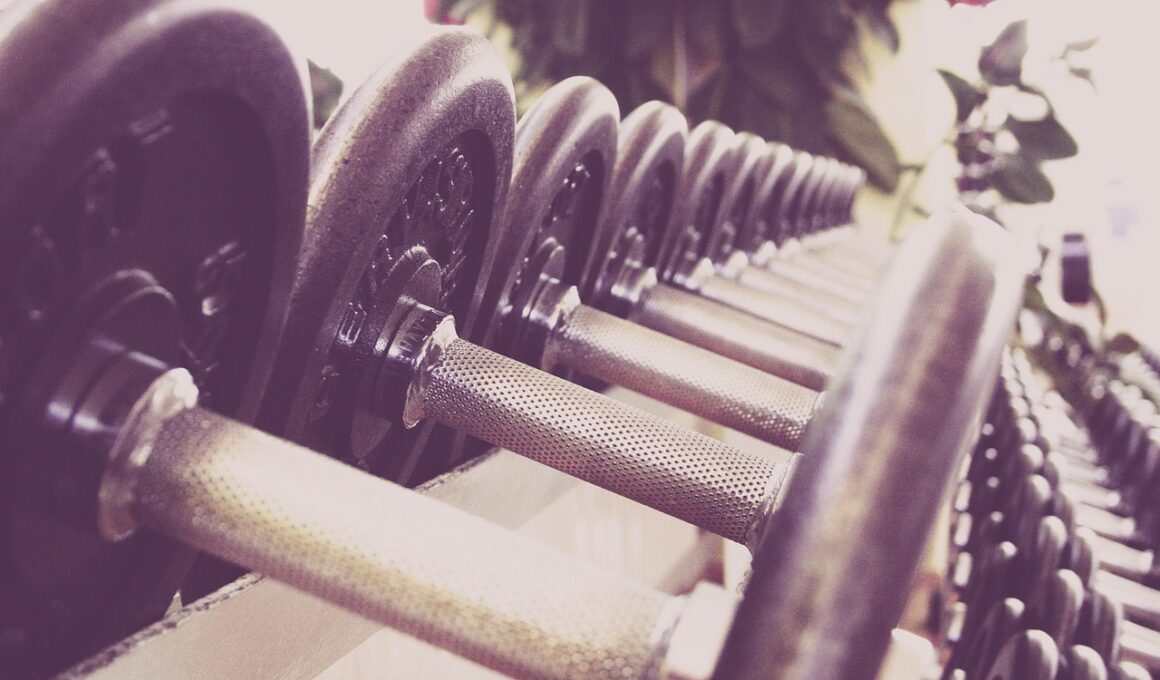How to Maintain and Care for Your Strength Training Equipment
Maintaining your strength training equipment is essential for ensuring its longevity and effectiveness. Proper care not only keeps your equipment in top shape but also enhances your safety during workouts. One primary aspect of maintenance is regular cleaning. Depending on the frequency of use, you should wipe down surfaces with a damp cloth and mild detergent after each session. Also, pay close attention to high-contact areas where sweat and grime can accumulate. Moreover, check and tighten bolts or screws weekly to prevent any loose parts from causing injury. Failure to do this can lead to significant problems with stability and safety over time. Additionally, consider placing equipment in a designated area to minimize exposure to moisture, which can rust metal parts. For further protection, using a cover when equipment is not in use can also help safeguard it from dust and sunlight. Finally, be proactive about inspecting your gear for wear and tear and address any issues promptly. Your strength training routine should be effective and safe, reflecting how much you care for the equipment you use.
In addition to routine cleaning and checks, proper storage is a vital component of equipment maintenance. Strength training tools, whether free weights or machines, benefit greatly from being stored correctly. Allowing weights or bands to sit on the ground can lead to damage or create trip hazards. Use racks or hooks designed to hold your weights efficiently. This organization not only saves space, but it also keeps the training environment tidy and safe. Ensure that heavy items are stored at lower levels to avoid accidents when accessing them. Furthermore, rubber mats can be beneficial beneath equipment to protect floors from heavy equipment and to minimize noise during workouts. If your gym includes machines, regularly check their moving parts for any signs of wear or excessive friction, lubricating them as necessary for smooth function. If you store equipment outdoors, consider the weather conditions. Investing in weather-resistant tools or covers will protect your gear from elements such as rain or excessive sun. Remember, a well-maintained and organized workout space can significantly enhance your training experience.
Routine Inspections
Regular inspection of your strength training equipment is crucial for safety and proper functioning. Schedule thorough equipment checks at least once a month or as needed, depending on your training frequency. Start by examining free weights and bars for rust, bends, or cracks. Any damage found should be addressed immediately to avoid costly repairs or injuries. After free weights, inspect rubber mats, benches, or smith machines. Look for tear or fraying on any padding, ensuring a safe workout environment. Additionally, pay attention to adjustment knobs or levers, ensuring they operate smoothly. Sturdy equipment should operate without any undue noise. If something does not feel right, do not hesitate to consult a professional or manufacturer for guidance. It’s essential to have proper documentation for warranties since many manufacturers offer support for repairs based on their policies. Having repair parts handy can save days of downtime if your equipment malfunctions. Overall, consistent inspections aid in prolonging the lifespan of your equipment while enhancing your overall training experience.
Lubricating Moving Parts
Lubrication is another essential area in maintaining strength training machines, especially those with numerous moving parts. Machines such as leg presses, lat pulldowns, and other cable systems often require regular lubrication to function correctly and quietly. Before applying lubricant, ensure the equipment is clean: dust, sweat, and dirt can accumulate in crevices, affecting performance. Selecting the appropriate lubricant is critical—use products specifically designed for gym equipment, as household oils may attract dust and dirt. Apply the lubricant according to the manufacturer’s instructions, generally on moving joints and any moving parts that come into contact. After lubricating, operate the machine through a full range of motion to ensure the lubricant is evenly distributed. A smooth functioning machine enhances both safety and effectiveness during workouts. Oversight in this area can lead to accelerated wear and tear, which could necessitate costly repairs. Regular maintenance of your equipment, such as lubrication, not only ensures peak performance but also creates a safer workout environment for you and others.
Another crucial maintenance tip is to check the cables and pulleys of machines regularly. These components experience significant stress during workouts and could deteriorate over time. Inspect cables for fraying, cuts, or any signs of damage; replace them immediately to prevent injuries. Pulleys, on the other hand, should rotate freely without any grinding sounds. If there are any issues, it might indicate misalignment or a need for lubrication. Proper alignment also ensures optimal performance during exercises. A small misalignment can lead to uneven wear on your equipment, which could become a serious issue if not addressed promptly. Store cables properly after workouts—avoid kinks or coils that might lead to damage over time. Take particular care with adjustable weight stacks—they should smoothly and evenly move during exercises without anyone needing to force them. Remember that maintaining equipment not only extends its life but also directly affects your fitness journey. Ultimately, it is about safety and the quality of your workouts, making this step critical.
Invest in Quality Equipment
Investing in high-quality strength training equipment can save you time and money by reducing the need for repairs and replacements. While cheaper options may seem appealing initially, they often lack durability and require more maintenance over time. Research brands and products before making a purchase; reading customer reviews can provide insights into equipment performance and longevity. Consider items with warranties that may cover damages for an extended period—this can be invaluable if anything goes wrong. Quality equipment is often manufactured with better materials that withstand the rigors of everyday use. In addition, premium options often come with clear maintenance guidelines, making it easier to care for your equipment properly. Additionally, consider purchasing equipment that offers versatility. Multi-functional items save space and increase workout variety, which aids motivation and consistency in your strength training regimen. Enhanced durability and functionality lead to better results over time, making the initial investment worthwhile. Assess your needs carefully and approach purchases wisely to develop a home gym that persistently serves you well for years.
Finally, remember that proper education plays a critical role in maintaining your strength training equipment effectively. Understanding how each piece functions will empower you to make informed decisions about maintenance and repairs. Reading the user manuals can provide essential instructions for setup, usage, and care tailored specifically to your equipment. Online articles and videos can offer valuable insights on maintaining and troubleshooting common equipment problems. Lastly, engaging with local fitness communities can provide feedback on your practices and introduce new maintenance strategies. Participating in forums or fitness groups enables you to share experiences and learn from others regarding effective equipment care methods. Consider seeking professional equipment services if you’re unsure about specific maintenance tasks. A professional perspective can help in identifying potential issues early, ensuring you maintain a safe training environment. Ultimately, the proper approach to maintaining strength training equipment not only enhances your safety and effectiveness during workouts but also supports your overall health and fitness journey.
In conclusion, understanding how to maintain and care for strength training equipment is fundamental to a successful and safe fitness journey. By integrating proper cleaning, inspections, lubrication, and storage into your routine, you can prolong the life of your gear while improving your workout experience. Remember that regular checks can prevent small issues from escalating into significant problems, ultimately ensuring safety during workouts. Choosing high-quality equipment also minimizes maintenance and maximizes durability, making your investment worthwhile. Lastly, educate yourself and engage with communities to enhance your understanding and practices in effective equipment care. The dedication you invest in maintaining your gear will reflect in your training results and overall fitness achievements, creating a conducive and motivating workout environment. By following these guidelines, you’ll foster not only a safer space but one that inspires you to continue challenging yourself in your strength training pursuits. Remember, every bit of effort you put into equipment care contributes to better results and a more enjoyable training experience.


